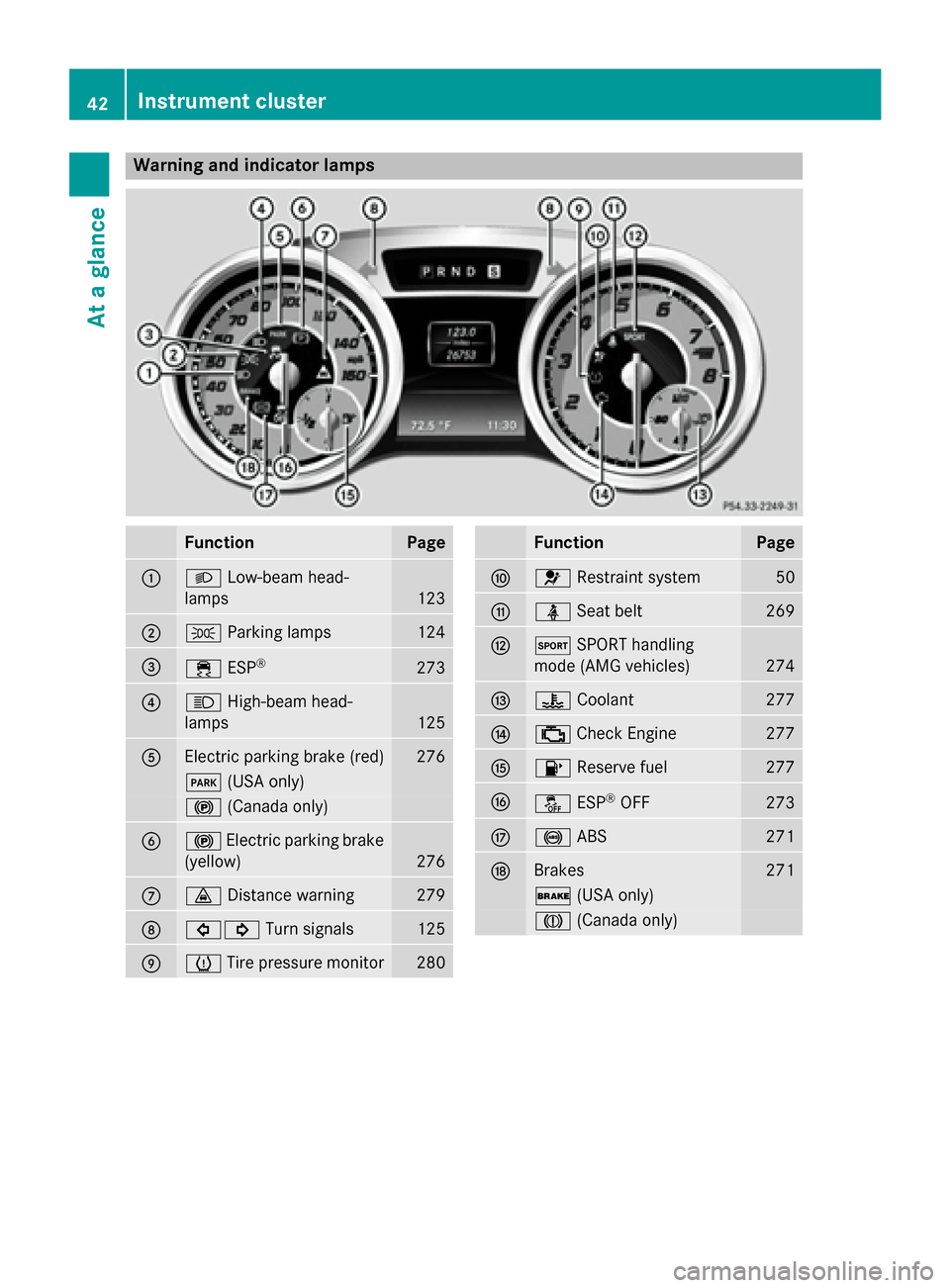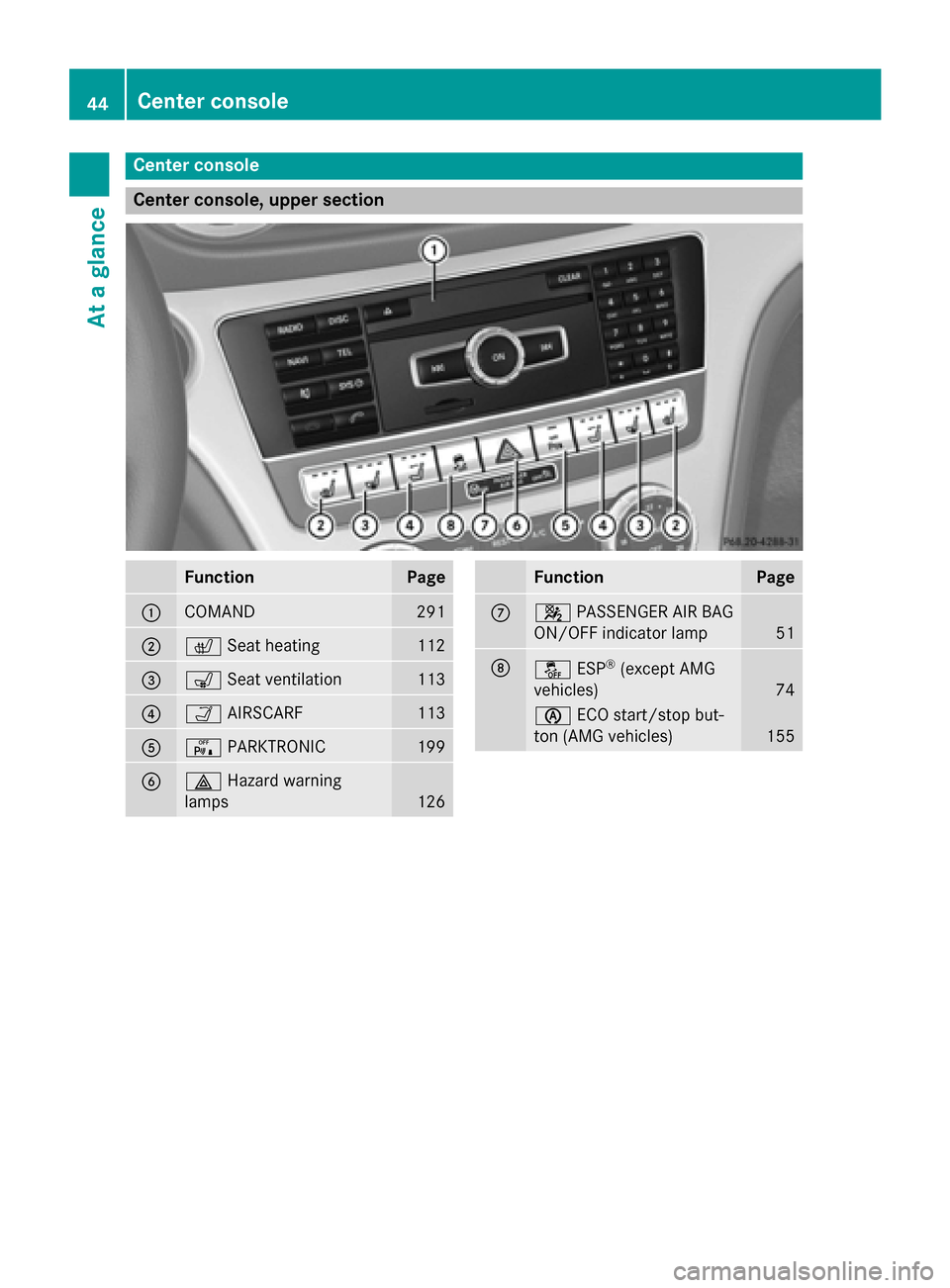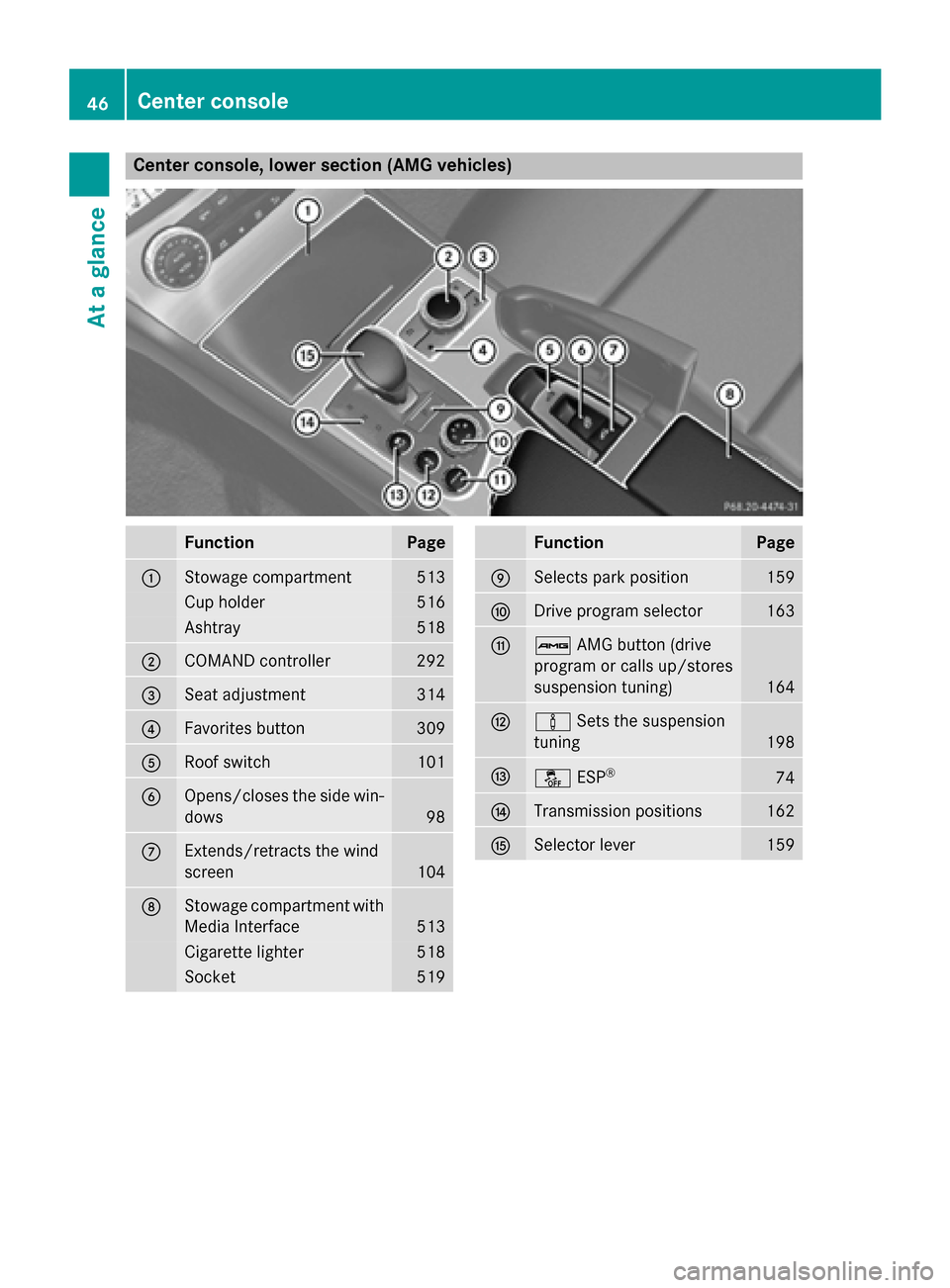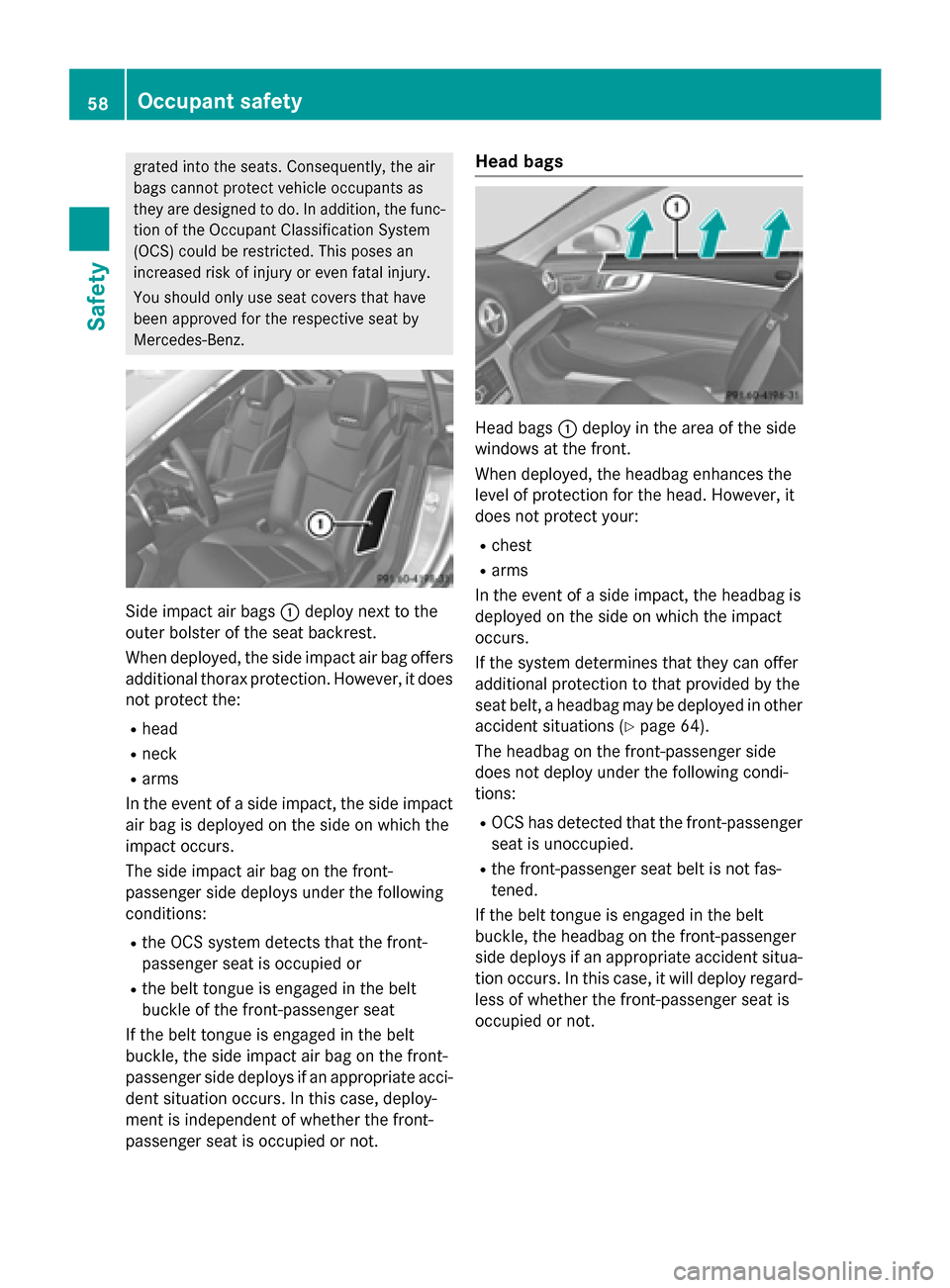ESP MERCEDES-BENZ SL-Class 2015 R131 User Guide
[x] Cancel search | Manufacturer: MERCEDES-BENZ, Model Year: 2015, Model line: SL-Class, Model: MERCEDES-BENZ SL-Class 2015 R131Pages: 610, PDF Size: 12.21 MB
Page 44 of 610

Warning and indicator lamps
Function Page
0043
0058
Low-beam head-
lamps 123
0044
0060
Parking lamps 124
0087
00E5
ESP® 273
0085
0057
High-beam head-
lamps 125
0083
Electric parking brake (red) 276
0049
(USA only) 0024
(Canada only) 0084
0024
Electric parking brake
(yellow) 276
006B
00BA
Distance warning 279
006C
003E003D
Turn signals 125
006D
0077
Tire pressure monitor 280 Function Page
006E
0075
Restraint system 50
006F
00E9
Seat belt 269
0070
0074
SPORT handling
mode (AMG vehicles) 274
0071
00AC
Coolant 277
0072
00B9
Check Engine 277
0073
00B6
Reserve fuel 277
0074
00BB
ESP®
OFF 273
0075
0025
ABS 271
0076
Brakes 271
0027
(USA only) 004D
(Canada only) 42
Instrument clusterAt a glance
Page 46 of 610

Center console
Center console, upper section
Function Page
0043
COMAND 291
0044
0072
Seat heating 112
0087
008E
Seat ventilation 113
0085
00CE
AIRSCARF 113
0083
008F
PARKTRONIC 199
0084
002F
Hazard warning
lamps 126 Function Page
006B
0073
PASSENGER AIR BAG
ON/OFF indicator lamp 51
006C
00BB
ESP®
(except AMG
vehicles) 74
00D6
ECO start/stop but-
ton (AMG vehicles) 15544
Center consoleAt a glance
Page 48 of 610

Center console, lower section (AMG vehicles)
Function Page
0043
Stowage compartment 513
Cup holder 516
Ashtray 518
0044
COMAND controller 292
0087
Seat adjustment 314
0085
Favorites button 309
0083
Roof switch 101
0084
Opens/closes the side win-
dows 98
006B
Extends/retracts the wind
screen
104
006C
Stowage compartment with
Media Interface 513
Cigarette lighter 518
Socket 519 Function Page
006D
Selects park position 159
006E
Drive program selector 163
006F
00CB
AMG button (drive
program or calls up/stores
suspension tuning) 164
0070
00CC
Sets the suspension
tuning 198
0071
00BB
ESP® 74
0072
Transmission positions 162
0073
Selector lever 15946
Center consoleAt a glance
Page 60 of 610

grated into the seats. Consequently, the air
bags cannot protect vehicle occupants as
they are designed to do. In addition, the func- tion of the Occupant Classification System
(OCS) could be restricted. This poses an
increased risk of injury or even fatal injury.
You should only use seat covers that have
been approved for the respective seat by
Mercedes-Benz. Side impact air bags
0043deploy next to the
outer bolster of the seat backrest.
When deployed, the side impact air bag offers additional thorax protection. However, it doesnot protect the:
R head
R neck
R arms
In the event of a side impact, the side impact
air bag is deployed on the side on which the
impact occurs.
The side impact air bag on the front-
passenger side deploys under the following
conditions:
R the OCS system detects that the front-
passenger seat is occupied or
R the belt tongue is engaged in the belt
buckle of the front-passenger seat
If the belt tongue is engaged in the belt
buckle, the side impact air bag on the front-
passenger side deploys if an appropriate acci-
dent situation occurs. In this case, deploy-
ment is independent of whether the front-
passenger seat is occupied or not. Head bags
Head bags
0043deploy in the area of the side
windows at the front.
When deployed, the headbag enhances the
level of protection for the head. However, it
does not protect your:
R chest
R arms
In the event of a side impact, the headbag is
deployed on the side on which the impact
occurs.
If the system determines that they can offer
additional protection to that provided by the
seat belt, a headbag may be deployed in other
accident situations (Y page 64).
The headbag on the front-passenger side
does not deploy under the following condi-
tions:
R OCS has detected that the front-passenger
seat is unoccupied.
R the front-passenger seat belt is not fas-
tened.
If the belt tongue is engaged in the belt
buckle, the headbag on the front-passenger
side deploys if an appropriate accident situa- tion occurs. In this case, it will deploy regard- less of whether the front-passenger seat is
occupied or not. 58
Occupant safetySafety
Page 62 of 610

aware of the status of the front-passenger
front air bag both before and during the jour- ney.
If the PASSENGER AIR BAG OFF indicator
lamp:
R is lit , the front-passenger front air bag is
deactivated. They will then not be deployed
in the event of an accident.
R does not light up : the front-passenger
front air bag is enabled. If, in the event of an
accident, all deployment criteria are met,
the front-passenger front air bag is
deployed. G
WARNING
If the PASSENGER AIR BAG OFF indicator
lamp is lit, the front-passenger front air bag is disabled. It will not be deployed in the event of
an accident and cannot perform its intended
protective function. A person in the front-
passenger seat could then, for example, come
into contact with the vehicle's interior, espe-
cially if the person is sitting too close to the
dashboard. This poses an increased risk of
injury or even fatal injury.
When the front-passenger seat is occupied,
always ensure that:
R the classification of the person in the front-
passenger seat is correct and the front-
passenger front air bag is enabled or disa-
bled in accordance with the person in the
front-passenger seat
R the front-passenger seat has been moved
back as far back as possible.
R the person is seated correctly.
Make sure, both before and during the jour-
ney, that the status of the front-passenger
front air bag is correct. G
WARNING
If you secure a child in a child restraint system on the front-passenger seat and the
PASSENGER AIR BAG OFF indicator lamp is
off, the front-passenger front air bag can
deploy in the event of an accident. The child could be struck by the air bag. This poses an
increased risk of injury or even fatal injury.
Make sure that the front-passenger front air
bag has been disabled. The PASSENGER AIR
BAG OFF indicator lamp must be lit. G
WARNING
If you secure a child in a forward-facing child
restraint system on the front-passenger seat
and you position the front-passenger seat too close to the dashboard, in the event of an
accident, the child could:
R come into contact with the vehicle's inte-
rior if the PASSENGER AIR BAG OFF indi-
cator lamp is lit, for example
R be struck by the air bag if the PASSENGER
AIR BAG OFF indicator lamp is off
This poses an increased risk of injury or even fatal injury.
Always move the front-passenger seat as far
back as possible and fully retract the seat
cushion length. Always make sure that the
shoulder belt strap is correctly routed from
the vehicle seat belt guide to the shoulder belt
guide on the child restraint system. The shoul-
der belt strap must be routed forwards and
downwards from the seat belt guide. Always
observe the child restraint system manufac-
turer's installation instructions.
If OCS determines that: R the front-passenger seat is unoccupied, the
PASSENGER AIR BAG OFF indicator lamp
lights up after the system self-test and
remains lit. This indicates that the front-
passenger front air bag is deactivated.
R the front-passenger seat is occupied by a
child of up to 12 month sold, in a standard
child restraint system, the PASSENGER AIR BAG OFF indicator lamp lights up after the
system self-test and remains lit. This indi-
cates that the front-passenger front air bag
is deactivated.
But in the case of a 12-month-old child, in a standard child restraint system, the
PASSENGER AIR BAG OFF indicator lamp 60
Occupant safetySafety
Page 63 of 610

can go out after the system self-test. This
indicates that the front-passenger front air bag is activated. The result of the classifi-
cation is dependent on, among other fac-
tors, the child restraint system and the
child's stature. Make sure that the condi-
tions for a correct classification are met. If
the PASSENGER AIR BAG OFF indicator
lamp remains off, do not install a child
restraint system on the front-passenger
seat.
R the front-passenger seat is occupied by a
person of smaller stature (e.g. a teenager
or small adult), the PASSENGER AIR BAG
OFF indicator lamp lights up and remains lit
after the system self-test depending on the result of the classification or, alternatively,
goes out.
- if the PASSENGER AIR BAG OFF indicator
lamp is off, move the front-passenger
seat as far back as possible.
- if the PASSENGER AIR BAG OFF indicator
lamp is lit, a person of smaller stature
should not use the front-passenger seat.
R the front-passenger seat is occupied by an
adult or a person of a stature correspond-
ing to that of an adult, the PASSENGER AIR
BAG OFF indicator lamp goes out after the
system self-test. This indicates that the
front-passenger front air bag is activated.
If children are traveling in the vehicle, be sure to observe the notes on "Children in the vehi-
cle" (Y page 68).
When OCS is malfunctioning, the red 0075
restraint system warning lamp in the instru-
ment cluster and the PASSENGER AIR BAG
OFF indicator lamp light up simultaneously.
The front-passenger front air bag is deactiva- ted in this case and does not deploy during an
accident. Have the system checked by quali-
fied technicians as soon as possible. Consult
an authorized Mercedes-Benz Center. The
front-passenger seat should only be repaired at an authorized Mercedes-Benz Center.
If the front-passenger seat, the seat cover or the seat cushion is damaged, have the nec- essary repair work carried out at an author-
ized Mercedes-Benz Center.
For safety reasons, Mercedes-Benz recom-
mends that you only use seat accessories
that have been approved by Mercedes-Benz.
If the driver's air bag deploys, this does not
mean that the front-passenger front air bag
will also deploy. The Occupant Classification
System (OCS) categorizes the occupant in the
front-passenger seat. Depending on that
result, the front-passenger front air bag is
either enabled or deactivated.
System self-test G
DANGER
If the PASSENGER AIR BAG OFF indicator
lamp does not light up during the system self- test, then the system is malfunctioning. The
front-passenger front air bag might be trig-
gered unintentionally or might not be trig-
gered at all in the event of an accident with
high deceleration. This poses an increased
risk of injury or even fatal injury.
In this case the front-passenger seat may not be used. Do not install a child restraint system
on the front-passenger seat. Have the Occu-
pant Classification System (OCS) checked
and repaired immediately at a qualified spe-
cialist workshop. G
DANGER
If the PASSENGER AIR BAG OFF indicator
lamp remains lit after the system self-test, the front-passenger front air bag is disabled. It willnot be deployed in the event of an accident. In
this case, the front-passenger front air bag
cannot perform its intended protective func-
tion, e.g. when a person is seated in the front- passenger seat.
That person could, for example, come into
contact with the vehicle's interior, especially
if the person is sitting too close to the dash-
board. This poses an increased risk of injury or even fatal injury. Occupant safety
61Safety
Z
Page 65 of 610

Problems with the Occupant Classification System (OCS)
Be sure to observe the notes on "System self-test" (Y
page 61).Problem
Possible causes/consequences and
0050
0050Solutions The PASSENGER AIR
BAG OFF indicator
lamp lights up and
remains lit, even
though the front-
passenger seat is occu-
pied by an adult or a
person of a stature cor-
responding to that of an
adult. The classification of the person on the front-passenger seat is
incorrect.
X Make sure the conditions for a correct classification of the per-
son on the front-passenger seat are met (Y page 59).
X If the PASSENGER AIR BAG OFF indicator lamp remains lit, the
front-passenger seat may not be used.
X Have OCS checked as soon as possible at an authorized
Mercedes-Benz Center. The PASSENGER AIR
BAG OFF indicator
lamp does not light up
and/or does not stay
on.
The front-passenger
seat is:
R unoccupied
R occupied by the
weight of a child up
to 12 months old in a
child restraint sys-
tem OCS is malfunctioning.
X Make sure there is nothing between the seat cushion and the
child seat.
X Make sure that the entire base of the child restraint system rests
on the seat cushion of the front-passenger seat. The backrest of
the forwards-facing child restraint system must, as far as pos-
sible, be resting on the backrest of front-passenger seat. If nec- essary, adjust the position of the front-passenger seat.
X Make sure that the seat cushion length is fully retracted.
X When installing the child restraint system, make sure that the
seat belt is tight. Do not pull the seat belt tight with the front-
passenger seat adjustment. This could result in the seat belt and the child restraint system being pulled too tightly.
X Check the installation of the child restraint system.
Make sure that the head restraint does not apply a load to the
child restraint system. If necessary, adjust the head restraint
accordingly.
X Make sure that no objects are applying additional weight onto
the seat.
X If the PASSENGER AIR BAG OFF indicator lamp remains off, do
not install a child restraint system on the front-passenger seat.
X Have OCS checked as soon as possible at an authorized
Mercedes-Benz Center. Roll bar
G
DANGER
If the roll bar has developed a malfunction, it
may not function, e.g. in the event of an acci- dent. The roll bars may then not protect the
vehicle occupants as intended. This poses an
increased risk of injury or even fatal injury.
Have roll bars checked immediately at a quali-
fied specialist workshop. Occupant safety
63Safety Z
Page 66 of 610

G
WARNING
If you place objects or clothing on the roll bar covers, these could impair roll bar extension.
The roll bars may then not protect the vehicle occupants as intended. In addition, objects
could endanger the vehicle occupants when
the roll bar is extending. This poses an
increased risk of injury or even fatal injury.
Ensure that the movement area of the roll bar covers is kept clear. Always stow all objects in
the vehicle correctly. The roll bars are located in the rear area of the
vehicle under the two outer rear compart-
ment trim covers.
They extend if systems detect that the vehicle
is in danger of rollover. The two outer rear
compartment trim covers are opened and the roll bars are extended within fractions of a
second.
Once the roll bars are extended, you can no
longer lower them. An open roof can no lon-
ger be closed. In this case, visit the nearest
qualified specialist workshop. Deployment of Emergency Tensioning
Devices and air bags
Important safety notes G
WARNING
The air bag parts are hot after an air bag has
been deployed. There is a risk of injury. Do not touch the air bag parts. Have a
deployed air bag replaced at a qualified spe-
cialist workshop as soon as possible.
G
WARNING
A deployed air bag no longer offers any pro-
tection and cannot provide the intended pro-
tection in an accident. There is an increased
risk of injury.
Have the vehicle towed to a qualified special- ist workshop in order to have a deployed air
bag replaced.
It is important for your safety and that of your
passenger to have deployed air bags replaced and to have any malfunctioning air bags
repaired. This will help to make sure the air
bags continue to perform their protective
function for the vehicle occupants in the
event of a crash. G
WARNING
Pyrotechnic Emergency Tensioning Devices
that have been deployed are no longer opera- tional and are unable to perform their inten-
ded protective function. This poses an
increased risk of injury or even fatal injury.
Therefore, have pyrotechnic Emergency Ten-
sioning Devices which have been triggered
immediately replaced at a qualified specialist workshop.
An electric motor is used by PRE-SAFE ®
to
trigger the tightening of the seat belt in haz-
ardous situations. This procedure is reversi-
ble.
If the Emergency Tensioning Devices or air
bags are deployed, you will hear a bang and a small amount of powder may also be
released. The 0075restraint system warning
lamp will light up.
Only in rare cases will the bang affect your
hearing. The powder released is generally not hazardous to health, it could however cause
short-term breathing difficulties in people
with asthma or other respiratory problems. In
order to prevent breathing difficulties, you 64
Occupant safetySafety
Page 67 of 610

should leave the vehicle as soon as it is safe to
do so, or open the window.
Air bags and pyrotechnic seat belt tensioners
contain perchlorate material, which may
require special handling or environmental
protection measures. Check with your local
government’s disposal guidelines. California
residents, see www.dtsc.ca.gov/
HazardousWaste/Perchlorate/
index.cfm.
Method of operation During the first stage of a collision, the
restraint system control unit evaluates impor-
tant physical data relating to vehicle deceler-
ation or acceleration, such as:
R Duration
R Direction
R Intensity
Based on the evaluation of this data, the
restraint system control unit triggers the belt
tensioners in the event of a frontal or rear
collision.
An Emergency Tensioning Device can only be
triggered if:
R the ignition is switched on
R the restraint system components are ready
for operation, see “Restraint system warn-
ing lamp” (Y page 51)
R the belt tongue is inserted into the buckle
on the respective front seat
If the restraint system control unit detects a
high accident severity, additional compo-
nents of the restraint system are activated
independently of one another in certain fron- tal collision situations:
R Front air bags as well as driver's and front-
passenger kneebag
Depending on the person occupying the front-
passenger seat, the front-passenger air bag is activated or deactivated. The front-passenger front air bag can only be deployed in an acci-
dent if the PASSENGER AIR BAG OFF indica-
tor lamp is off. Observe the information on the PASSENGER AIR BAG OFF indicator lamp
(Y
page 51).
Your vehicle has two-stage front air bags.
During the first deployment stage, the front
air bag fills with propellant gas which reduces the risk of injury. The second stage is then
triggered within milliseconds, filling the front
air bag with the maximum amount of propel-
lant gas.
The deployment thresholds for the Emer-
gency Tensioning Devices and air bags are
calculated on the basis of the vehicle decel-
eration or acceleration occurring at various
points in the vehicle. This process is pre-emp-
tive in nature. The air bag must be deployed
on time, at the start of the collision.
The rate of vehicle deceleration or accelera-
tion and the direction of the force are essen- tially determined by:
R distribution of the force during the impact
R collision angle
R deformation characteristics of the vehicle
R characteristics of the object with which the
vehicle has collided
Factors which can only be seen and measured after the collision has occurred do not play a
decisive role in the deployment of an airbag,
nor do they provide an indication of air bag
deployment.
The vehicle may be considerably deformed
without an air bag being deployed. This is the
case if only relatively easily deformable parts
have been hit and a high rate of deceleration
has not been reached. Conversely, an air bag may be deployed even though the vehicle suf-
fers only minor deformation. This is the case
if, for example, very rigid vehicle parts such as the longitudinal body members are hit in an
accident and the rate of deceleration is suffi-
cient. Occupant safety
65Safety Z
Page 68 of 610

If the restraint system control unit detects a
side impact or an overturn situation, the rel-
evant restraint system components are acti-
vated independently of one another depend-
ing on the apparent type of accident. If addi-
tional protection for the vehicle occupants is determined in this situation, the belt tension-
ers are also triggered.
R Sidebag on the side on which the impact
occurs, independently of the belt tensioner
and of the use of the seat belt on the driv-
er's seat
The sidebag on the front-passenger side
deploys under the following conditions:
- the OCS system detects that the front-
passenger seat is occupied or
- the belt tongue has engaged in the belt
buckle of the front-passenger seat.
R Headbag on the side on which the impact
occurs, independently of the use of the seat belt and independently of whether the
front-passenger seat is occupied
R Headbags on the driver's and front-
passenger sides in certain overturn situa-
tions if the system determines that they
can offer additional protection to that pro-
vided by the seat belt
i Not all air bags are deployed in an acci-
dent. The various air bag systems work
independently of each other.
How the air bag system works is deter-
mined by the severity of the accident detec- ted, especially the vehicle deceleration or
acceleration, and the apparent type of acci- dent:
R frontal collision
R side impact
R rollover NECK-PRO head restraints
Important safety notes G
WARNING
The function of the head restraint may be
impaired if you:
R attach objects such as coat hangers to the
head restraints, for example
R use head restraint covers
If you do so, the head restraints cannot fulfill
their intended protective function in the event of an accident. In addition, objects attached
to the head restraints could endanger other
vehicle occupants. There is an increased risk
of injury.
Do not attach any objects to the head
restraints and do not use head restraint cov-
ers.
Method of operation NECK-PRO head restraints reduce the likeli-
hood of head and chest injuries. The NECK-
PRO head restraints on the driver's and front-
passenger seats are moved forwards and
upwards in the event of a rear-end collision of
a certain severity. This provides better head
support.
If the NECK-PRO head restraints have been
triggered in an accident, you must reset the
NECK-PRO head restraints on the driver’s and
front-passenger seat (Y page 67). Other-
wise, the additional protection will not be
available in the event of another rear-end col- lision. You can recognize when NECK-PRO
head restraints have been triggered by the
fact that they have moved forwards and can
no longer be adjusted.
Mercedes-Benz recommends that you have
the NECK-PRO head restraints checked for
functionality at a qualified specialist work-
shop after a rear-end collision. 66
Occupant safetySafety